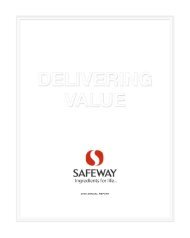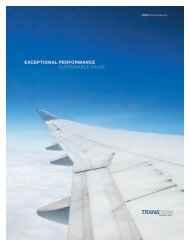Bemis Company 2007 Annual Report - IR Solutions
Bemis Company 2007 Annual Report - IR Solutions
Bemis Company 2007 Annual Report - IR Solutions
Create successful ePaper yourself
Turn your PDF publications into a flip-book with our unique Google optimized e-Paper software.
Blown film – A plastic film that is extruded through an angular die in the form of a tube and then expanded by a column of air in the<br />
manufacturing process.<br />
Cast film – A plastic film that is extruded through a straight slot die as a flat sheet during its manufacturing process.<br />
Coextruded film – A blown or cast film extruded with multiple layers extruded simultaneously.<br />
Controlled atmosphere packaging – A package which limits the flow of elements, such as oxygen or moisture, into or out of the package.<br />
Decorative products – Pressure sensitive materials used for decorative signage, promotional items, and displays and advertisements.<br />
Flexible polymer film – A non-rigid plastic film.<br />
Flexographic printing – The most common flexible packaging printing process in North America using a raised rubber or alternative<br />
material image mounted on a printing cylinder.<br />
In-line overlaminating capability – The ability to add a protective coating to a printed material during the printing process.<br />
Label products – Pressure sensitive materials made up and sold in roll form.<br />
Labelstock – Pressure sensitive material designed for the label markets.<br />
Modified atmosphere packaging – A package in which the atmosphere inside the package has been modified by a gas such as nitrogen.<br />
Monolayer film – A single layer extruded plastic film.<br />
Multiwall paper bag – A package made from two or more layers of paper that have not been laminated.<br />
Polyolefin shrink film – A packaging film consisting of polyethylene and/or polypropylene resins extruded via the blown process. The<br />
film can be irradiated in a second process to cross link the molecules for added strength, durability, and toughness. The product is<br />
characterized by thin gauge, high gloss, sparkle, transparency, and good sealing properties.<br />
Pressure sensitive material – A material coated with adhesive such that upon contact with another material it will stick.<br />
Rotogravure printing – A high quality, long run printing process utilizing a metal engraved cylinder.<br />
Sheet products – Pressure sensitive materials cut into sheets and sold in sheet form.<br />
Stretch film – A plastic film used to wrap pallets in the shipping process, which has significant ability to stretch.<br />
Technical products – Technically engineered pressure sensitive materials used primarily for fastening and mounting functions.<br />
Thermoformed plastic packaging – A package formed by applying heat to a film to shape it into a tray or cavity and then placing a flat<br />
film on top of the package after it has been filled.<br />
UV inhibitors – Chemicals which protect against ultraviolet rays.<br />
ITEM 1A – RISK FACTORS<br />
Funded status of pension plans—Recognition of pension liabilities may cause a significant reduction in stockholders’ equity.<br />
Statement of Financial Accounting Standards (FAS) No. 158, Employers’ Accounting for Defined Benefit Pension and Other<br />
Postretirement Plans, requires balance sheet recognition of the funded status of our defined benefit pension and postretirement benefit<br />
plans. If the fair value of our pension plans’ assets at a future reporting date decreases or if the discount rate used to calculate the<br />
projected benefit obligation (PBO) as of that date decreases, we will be required to record the incremental change in the excess of PBO<br />
over the fair value of the assets as a reduction of stockholders’ equity. The resulting non-cash after-tax charge would not reduce reported<br />
earnings. It would be recorded directly as a decrease in the Accumulated Other Comprehensive Income component of stockholders’<br />
equity. While we cannot estimate the future funded status of our pension liability with any certainty at this time, we believe that if the<br />
market value of assets or the discount rate used to calculate our pension liability materially decreases, the adjustment could significantly<br />
reduce our stockholders’ equity. A significant reduction in stockholders’ equity may impact our compliance with debt covenants or could<br />
cause a downgrade in our credit ratings that could also adversely impact our future cost and speed of borrowing and have an adverse<br />
affect on our financial condition, results of operations and liquidity. We have identified pension assumptions as critical accounting<br />
estimates. See “Management’s Discussion and Analysis of Financial Condition and Results of Operations—Critical Accounting<br />
Estimates and Judgments—Accounting for annual pension costs” and “—Pension assumptions sensitivity analysis” included in Item 7 of<br />
this <strong>Annual</strong> <strong>Report</strong> on Form 10-K.<br />
Goodwill and other intangible assets—A significant write down of goodwill and/or other intangible assets would have a material<br />
adverse effect on our reported results of operations and net worth.<br />
On January 1, 2002, we adopted Statement of Financial Accounting Standards No. 142, Goodwill and Other Intangible Assets<br />
(FAS No. 142). We no longer amortize goodwill, but we review our goodwill balance for impairment at least once a year using the<br />
business valuation methods required by FAS No. 142. These methods include the use of a weighted-average cost of capital to calculate<br />
the present value of the expected future cash flows of our reporting units. Future changes in the cost of capital, expected cash flows, or<br />
other factors may cause our goodwill and/or other intangible assets to be impaired, resulting in a non-cash charge against results of<br />
operations to write down these assets for the amount of the impairment. If a significant write down is required, the charge would have a<br />
material adverse effect on our reported results of operations and net worth. We have identified the valuation of intangibles as a critical<br />
accounting estimate. See “Management’s Discussion and Analysis of Financial Condition and Results of Operations—Critical<br />
Accounting Estimates and Judgments—Intangible assets and goodwill” included in Item 7 of this <strong>Annual</strong> <strong>Report</strong> on Form 10-K.<br />
Foreign operations—Conditions in foreign countries and changes in foreign exchange rates may reduce our reported results of<br />
operations.<br />
We have operations in North America, South America, Europe, and Asia. In <strong>2007</strong>, approximately 36 percent of our sales were<br />
generated by entities operating outside of the United States. Fluctuations in currencies can cause transaction and translation losses. In<br />
addition, our revenues and net income may be adversely affected by economic conditions, political situations, and changing laws and<br />
regulations in foreign countries, as to which we have no control.<br />
Interest rates—An increase in interest rates could reduce our reported results of operations.<br />
At December 31, <strong>2007</strong>, our variable rate borrowings approximated $533.9 million. Fluctuations in interest rates can increase<br />
borrowing costs and have an adverse impact on results of operations. Accordingly, increases in short-term interest rates will directly<br />
5







